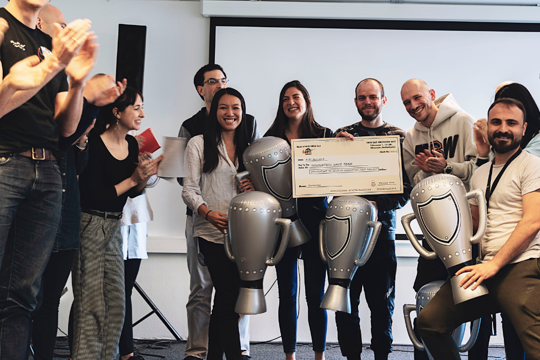
How to help anyone enact the strategy, every day.
In this article, you'll learn to avoid wasting time and resources on ideas and projects that don’t contribute to your core goals, by using a simple but powerful question to keep your team laser-focused.
You’ll learn:
-
How the Williams F1 Team uses the question “Will it make the car go faster?” to drive decisions and focus innovation.
-
Why defining a central question or goal can help your team prioritize effectively.
-
How to implement this strategy in your organization to ensure that every decision aligns with your primary objectives.
What's the one question everyone is working to answer in your business?
Teams are constantly bombarded with new ideas, opportunities, and potential distractions. It’s easy to get caught up in side projects or initiatives that, while interesting, don’t actually move the needle on your core objectives. This can lead to wasted resources, unfocused efforts, and missed opportunities.
The Williams Formula 1 Team faced a similar challenge. In the high-stakes world of Formula 1 racing, every decision matters. With limited time, resources, and budget, the team needed a way to stay focused on the one goal that truly mattered: making the car faster.
To help guide their decision-making process, they adopted a simple yet powerful question: “Will it make the car go faster?” This question became their guiding principle, helping the team filter out distractions, prioritize tasks, and focus on what would actually improve their race performance.
This concept can be applied to any organization or team. By defining a central question that aligns with your core goal, you can create a clear decision-making framework that keeps everyone focused on what matters most. Whether you’re developing a new product, streamlining operations, or executing a marketing campaign, asking a version of “Will it make the car go faster?” ensures that every action contributes to your overarching objectives.
The Power of Focus: Why “Will It Make the Car Go Faster?” Works
The reason the “Will it make the car go faster?” question is so effective is because it provides a simple, immediate filter for every decision the team faces. It helps strip away distractions, pet projects, and nice-to-haves, and zeroes in on what’s essential to success.
For the Williams F1 team, this single question guides every aspect of their operations, from car design to engineering, resource allocation, and team strategy. If an idea, task, or initiative won’t help improve race performance, it’s deprioritized or scrapped altogether.
The brilliance of this approach lies in its simplicity and clarity:
-
Clarity of Purpose: Everyone on the team knows what the ultimate goal is—making the car faster—and can align their efforts accordingly.
-
Faster Decision-Making: Instead of debating endlessly or getting bogged down in analysis paralysis, the team can quickly evaluate whether a task or idea contributes to the goal. If it doesn’t, it’s eliminated.
-
Resource Efficiency: Time, money, and energy are finite resources. By focusing on what directly impacts the goal, the team ensures that resources are used where they’ll have the greatest impact.
Applying “Will It Make the Car Go Faster?” to Your Team
While the Williams F1 team uses this principle in the context of race performance, the same approach can be applied to any business or organization. The key is to identify your team’s equivalent of “Will it make the car go faster?”—a guiding question that aligns with your core objective.
Here’s how you can implement this strategy within your own team:
1. Identify Your Core Objective
Before you can start asking your team’s version of “Will it make the car go faster?”, you need to clearly define what your core objective is. This is the single goal that, if achieved, will have the most significant positive impact on your organization’s success.
This could be:
-
Increasing revenue for a sales team.
-
Improving customer satisfaction for a service-based organization.
-
Delivering product innovations for a tech startup.
The key is to distill your mission down to a single, clear objective that the entire team can rally behind.
Example: If you’re running a product development team, your core objective might be, “Will it improve the customer experience?” This question would help you prioritize product features and updates that enhance the customer journey, while deprioritizing nice-to-have features that don’t add real value.
2. Frame a Guiding Question
Once you’ve defined your core objective, it’s time to frame a guiding question that can be applied consistently in decision-making processes. The question should be simple, direct, and aligned with the key outcome you want to achieve.
Example: If you’re focused on increasing revenue, your guiding question might be, “Will it help us close more deals?” For a team focused on innovation, the question could be, “Will it lead to breakthrough solutions?”
The goal is to have a question that everyone can refer to when evaluating new ideas, projects, or tasks.
3. Use the Question to Filter Decisions
Now that you have your guiding question, the next step is to apply it rigorously during decision-making. Encourage your team to ask this question in meetings, during brainstorming sessions, and when evaluating new initiatives.
Example: In product development meetings, when a new feature is proposed, the team could ask, “Will this feature improve customer satisfaction?” If the answer is no, it becomes easier to deprioritize that feature and focus on ones that align with the core objective.
This process helps reduce distractions and keeps the team focused on what really matters.
4. Foster a Culture of Focus and Accountability
For this strategy to be effective, it needs to become part of your team’s culture. Everyone should feel comfortable asking the guiding question and holding each other accountable for staying focused on the core objective.
Encourage open discussions where team members can challenge ideas or initiatives that don’t align with the goal. The more consistently the question is used, the more ingrained it becomes in your team’s decision-making process.
How you can start implementing these ideas
Here are some practical tips and reflective questions to help you implement this guiding question strategy in your own organization:
1. Define Your Team’s Core Objective:
-
Advice: Take time to identify the single most important goal that will drive success for your team. Once defined, ensure everyone understands it clearly.
-
Thought Starter: What is the one outcome that would have the greatest positive impact on my team’s success?
2. Create a Guiding Question:
-
Advice: Frame a simple, clear question that aligns with your core objective. Make sure it’s easy for the team to apply in decision-making scenarios.
-
Thought Starter: What question can we ask to ensure that every decision we make is aligned with our core goal?
3. Apply the Question in Every Decision:
-
Advice: Encourage your team to ask the guiding question during meetings, brainstorming sessions, and when evaluating new projects or initiatives.
-
Thought Starter: How can we embed this question into our daily decision-making processes to ensure we stay focused on our core objective?
Wrap-up: Create a simple manta that every person in your organisation can use to understand the strategic goal.
By adopting a guiding question like “Will it make the car go faster?”, you can help your team stay laser-focused on what really matters. Whether you’re trying to innovate, improve performance, or streamline operations, a clear, goal-oriented question cuts through distractions and ensures that every action contributes to your most important objectives.
In today’s fast-paced business environment, focus is a competitive advantage. By aligning your team around a single guiding question, you can drive faster decisions, greater resource efficiency, and ultimately, better results.
CHANGE BY SPRINT VALLEY
Ready for change?
Fast-track ambitious ideas and build a future-ready business your people are proud to be a part of.
